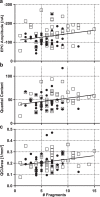Age-related fragmentation of the motor endplate is not associated with impaired neuromuscular transmission in the mouse diaphragm
- PMID: 27094316
- PMCID: PMC4837408
- DOI: 10.1038/srep24849
Age-related fragmentation of the motor endplate is not associated with impaired neuromuscular transmission in the mouse diaphragm
Abstract
As mammals age, their neuromuscular junctions (NMJs) gradually change their form, acquiring an increasingly fragmented appearance consisting of numerous isolated regions of synaptic differentiation. It has been suggested that this remodelling is associated with impairment of neuromuscular transmission, and that this contributes to age-related muscle weakness in mammals, including humans. The underlying hypothesis, that increasing NMJ fragmentation is associated with impaired transmission, has never been directly tested. Here, by comparing the structure and function of individual NMJs, we show that neuromuscular transmission at the most highly fragmented NMJs in the diaphragms of old (26-28 months) mice is, if anything, stronger than in middle-aged (12-14 months) mice. We suggest that NMJ fragmentation per se is not a reliable indicator of impaired neuromuscular transmission.
Conflict of interest statement
S.W. and M.N. are employees of Novartis Pharma, A.G. C.R.S declares no competing financial interest.
Figures



Similar articles
-
TrkB kinase activity maintains synaptic function and structural integrity at adult neuromuscular junctions.J Appl Physiol (1985). 2014 Oct 15;117(8):910-20. doi: 10.1152/japplphysiol.01386.2013. Epub 2014 Aug 28. J Appl Physiol (1985). 2014. PMID: 25170066 Free PMC article.
-
Loss of Protein Kinase Csnk2b/CK2β at Neuromuscular Junctions Affects Morphology and Dynamics of Aggregated Nicotinic Acetylcholine Receptors, Neuromuscular Transmission, and Synaptic Gene Expression.Cells. 2019 Aug 20;8(8):940. doi: 10.3390/cells8080940. Cells. 2019. PMID: 31434353 Free PMC article.
-
Age-related changes in the structure and function of mammalian neuromuscular junctions.Ann N Y Acad Sci. 2018 Jan;1412(1):41-53. doi: 10.1111/nyas.13521. Epub 2017 Dec 31. Ann N Y Acad Sci. 2018. PMID: 29291259 Review.
-
Diaphragm neuromuscular transmission failure in aged rats.J Neurophysiol. 2019 Jul 1;122(1):93-104. doi: 10.1152/jn.00061.2019. Epub 2019 May 1. J Neurophysiol. 2019. PMID: 31042426 Free PMC article.
-
Neuromuscular transmission on the rebound.Recept Channels. 2001;7(6):491-6. Recept Channels. 2001. PMID: 11918351 Review.
Cited by
-
Brain derived neurotrophic factor/tropomyosin related kinase B signaling impacts diaphragm neuromuscular transmission in a novel rat chemogenetic model.Front Cell Neurosci. 2022 Oct 28;16:1025463. doi: 10.3389/fncel.2022.1025463. eCollection 2022. Front Cell Neurosci. 2022. PMID: 36385943 Free PMC article.
-
A Role of Lamin A/C in Preventing Neuromuscular Junction Decline in Mice.J Neurosci. 2020 Sep 16;40(38):7203-7215. doi: 10.1523/JNEUROSCI.0443-20.2020. Epub 2020 Aug 17. J Neurosci. 2020. PMID: 32817327 Free PMC article.
-
What is Normal? Neuromuscular junction reinnervation after nerve injury.Muscle Nerve. 2019 Nov;60(5):604-612. doi: 10.1002/mus.26654. Epub 2019 Aug 23. Muscle Nerve. 2019. PMID: 31408210 Free PMC article.
-
AMP-Activated Protein Kinase as a Key Trigger for the Disuse-Induced Skeletal Muscle Remodeling.Int J Mol Sci. 2018 Nov 12;19(11):3558. doi: 10.3390/ijms19113558. Int J Mol Sci. 2018. PMID: 30424476 Free PMC article. Review.
-
Neuromuscular junction transmission failure is a late phenotype in aging mice.Neurobiol Aging. 2020 Feb;86:182-190. doi: 10.1016/j.neurobiolaging.2019.10.022. Epub 2019 Nov 5. Neurobiol Aging. 2020. PMID: 31866157 Free PMC article.
References
-
- Slater C. R. Reliability of neuromuscular transmission and how it is maintained. HandbClinNeurol 91, 27–101 (2008). - PubMed
-
- Engel A. G. Chapter 3 The neuromuscular junction. HandbClinNeurol 91, 103–148 (2008). - PubMed
-
- Barker D. & Ip M. C. Sprouting and degeneration of mammalian motor axons in normal and de-afferentated skeletal muscle. Proceedings of the Royal Society of London B 163, 538–554 (1966). - PubMed
-
- Oda K. Age changes of motor innervation and acetylcholine receptor distribution on human skeletal muscle fibres. J Neurol Sci 66, 327–338 (1984). - PubMed
-
- Wokke J. H., Jennekens F. G., Van den Oord C. J., Veldman H., Smit L. M. & Leppink G. J. Morphological changes in the human end plate with age. J Neurol Sci 95, 291–310 (1990). - PubMed
MeSH terms
Substances
LinkOut - more resources
Full Text Sources
Other Literature Sources
Research Materials

